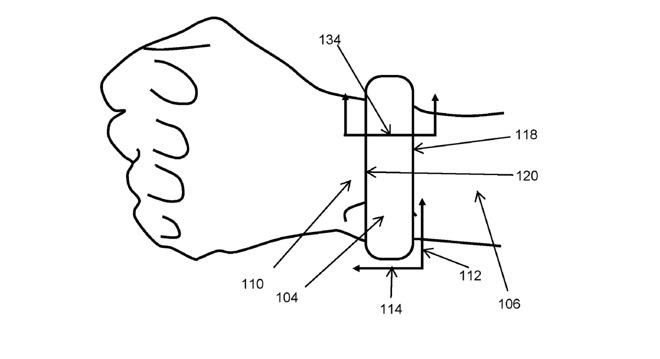One of Apple's next moves in health care could be this blood pressure instrument
Continuing Apple's push into the health space, the company has done some research on a low-profile blood pressure measurement system compatible with technologies like the iPhone and Apple Watch.

Apple on Thursday was granted a patent for what appears to be a blood pressure-measuring device that connects to existing Apple devices.
"The system includes an expandable member or structure that has a multi-compartment structure and/or is mounted on a rigid surface or structure," reads the patent, issued from the U.S. Trademark and Patent Office. "The system is incorporated into a portable multi-function device, or is configured to communicate with a portable multi-function device."
Photos attached imply that the "portable multi-function device" referenced is the Apple Watch.
The patent application, titled "Cuff Designs and Methods" is credited to six Apple employees, with it filed in June 2016.
Apple launched HealthKit in 2004, and has continued to expand its functionality since. Earlier this year, Apple signed up 12 major U.S. health care providers to support Health Records in iOS, an effort to digitize health records and easily help providers share data while treating patients; that number has since expanded to 39. Earlier this week, Apple opened its Health Records API to developers.
A third-party, HealthKit-compatible blood-pressure monitor, QardioArm by Qardio, is available in Apple's retail stores. And last November, a study found that the Apple Watch can be used to detect such conditions as sleep apnea and hypertension.

Apple on Thursday was granted a patent for what appears to be a blood pressure-measuring device that connects to existing Apple devices.
"The system includes an expandable member or structure that has a multi-compartment structure and/or is mounted on a rigid surface or structure," reads the patent, issued from the U.S. Trademark and Patent Office. "The system is incorporated into a portable multi-function device, or is configured to communicate with a portable multi-function device."
Photos attached imply that the "portable multi-function device" referenced is the Apple Watch.
Good health
The product, should it come to fruition, would be Apple's first full-on medical device, and subject to US Food and Drug Administration oversight, which it has been reluctant to do. However, Apple has gotten much more ambitious about health-related software applications in recent years.The patent application, titled "Cuff Designs and Methods" is credited to six Apple employees, with it filed in June 2016.
Apple launched HealthKit in 2004, and has continued to expand its functionality since. Earlier this year, Apple signed up 12 major U.S. health care providers to support Health Records in iOS, an effort to digitize health records and easily help providers share data while treating patients; that number has since expanded to 39. Earlier this week, Apple opened its Health Records API to developers.
Apple and blood pressure
Apple had filed a separate patent in October of 2017, for "intelligent blood pressure monitoring," but the new patent is different in at least one respect -- it does not contain the word "intelligent."A third-party, HealthKit-compatible blood-pressure monitor, QardioArm by Qardio, is available in Apple's retail stores. And last November, a study found that the Apple Watch can be used to detect such conditions as sleep apnea and hypertension.

Comments
Glanced through patent and it only references one previous patent. The patent looks like it describes a mini, inflatable device like the normal blood pressure cuff applied to the upper arm. This would be a very interesting device if they could get it to work properly with just the installed battery.
Since the obsolescence of old style mercury column devices, which was the gold standard, today various manufacturers use different algorithms to process the electronic sensor readings so there is some variance from device to device. They may need to get FDA approval but I would assume the disclaimers will be quite lengthy.
On the other hand it may just be one of those defensive patents that Apple has no intension of actually manufacturing.
While the automatic electronic cuffs do tend to read higher than mercury varieties thay are consistent in their interpretations over time. Humans are only as consistent as their intake of caffeine, loud music, etc.
if Apple goes forward with this one can be sure that they will exceed most current blood pressure monitoring devices by a significant margin.
Apple Watch is already capable of identifying when it’s wearer is at rest and I am confident it could coach and train wearers how to position themselves for an accurate measurement.
A device for measuring pressure, when it is required to wear a cuff, then it seems to me that the air is becoming obsolete and its place in the museum. In the 21st century, an apparatus based on other principles of measuring pressure-without cuffs and air pumping-should be developed. It should measure the pressure with the highest accuracy, CONSTANTLY, with the output of information in digital form on the smartphone-computer and, importantly, in conjunction with the non-invasive blood sensor (+ still sensors?) And the neural network, put a preliminary analysis of the cause of the increased (lowered) pressure and give advice on treatment. Something like this...